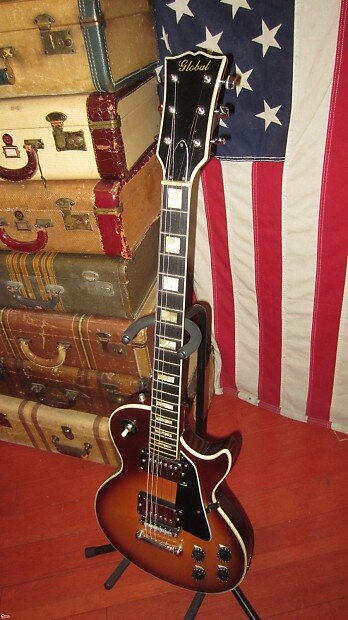"Lesser Pauls" from the Shadowy Seventies
We’re not talking about the Norlin-era Gibsons here, and we’re not even talking about the golden age of “lawsuit” guitars from Ibanez. There’s an island of even more misfit toys, but they started up and drove a lot of rock’n’roll dreams. They used to hang in pawn shops, lean in corners, and find themselves marked way, way down at yard sales, but these days you’re more likely to see these Les(ser) Pauls on eBay or Craigslist. They’re the bolt-on-neck, usually-plywood-body beasts from a variety of brands, and they’ve got their own thing going.
The big name (okay, it’s not that big) among these guitars is Hondo, but other brands include Memphis, Montaya, Global, Magnum, and others. These guitars chase the vintage Les Paul look with varying degrees of accuracy, but that’s where the excitement lies. Many of their fretboards have the large block inlays of the Les Paul Custom, while others have plain old dots. Almost none of these cheapo LP’s have the trapezoid inlays found on the Les Paul Standard and similar lines. The body styles alternate between the flat-topped slab body style of the LP Specials or Junior, or the bound, arched top of the more typical LP.
Unlike the solid wood construction of Gibson and other more expensive brands, a common trait of these off-brands is a plywood or laminated body “slab” with a hollow arched top. This essentially gives these guitars a type of chambered or almost semi-hollow construction with a slight space between the back and the top. Owing to the period in history that birthed them, you’ll often find finishes in the cherry sunburst favored by Kiss guitarist Ace Frehley, the black-with-cream look of Peter Frampton’s Les Paul, or even the Frankenstripes of early Eddie Van Halen.
Digging under the hood reveals some big differences in the pickup department. Urban legend holds that some (many? a few?) Hondos had DiMarzio humbuckers installed stock. While a good number of these humbuckers show up with some combination of cream-colored pickup bobbins or hex-screw polepieces, don’t assume these are all genuine DiMarzio pickups. No-name pickups with a similar look do exist, and they are most certainly going to end up in cheap guitars. Some of the chrome-covered pickups in these LP copies have also turned out to be humbuckers in looks only. Under the humbucker-sized covers there’s one set of polepieces screwed into a bracket sitting on top of a ceramic magnet, with a rectangular coil of wire around it. Turns out it’s a single-coil pickup taking up half of the space under the metal cover.
1979 Global Les Paul.
Photo Credit: Rivington Guitars. NY, NY.
Despite the odd design of the pickup, the sound is pretty good, with a little more body than a typical Strat sound, maybe closer to a gold foil or lipstick kind of tone. The fit and finish are where these guitars shine, despite their bolt-on necks and faux humbuckers. One I owned had neck and body binding, no rough fret ends, and a nicely done glossy finish, unlike the partially-finished look of some of today’s entry-level guitars. Finally, for those wanting a believable Gibson look at a distance, the cutaway has the correct “lawsuit” shape, making it stand out from most other LP copies produced today.





